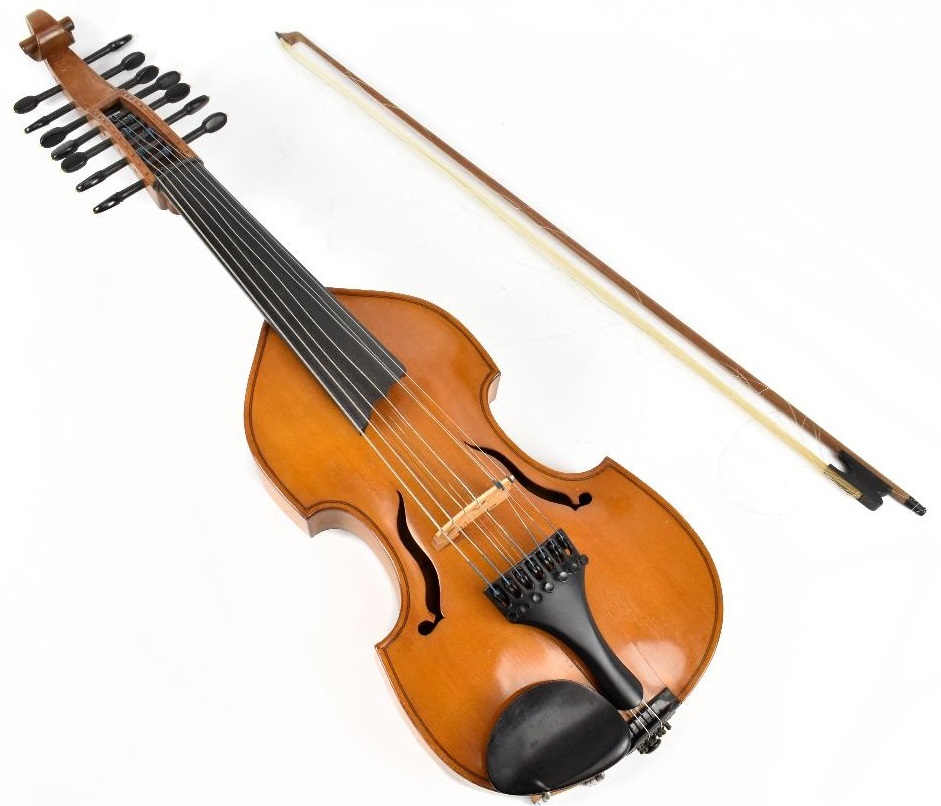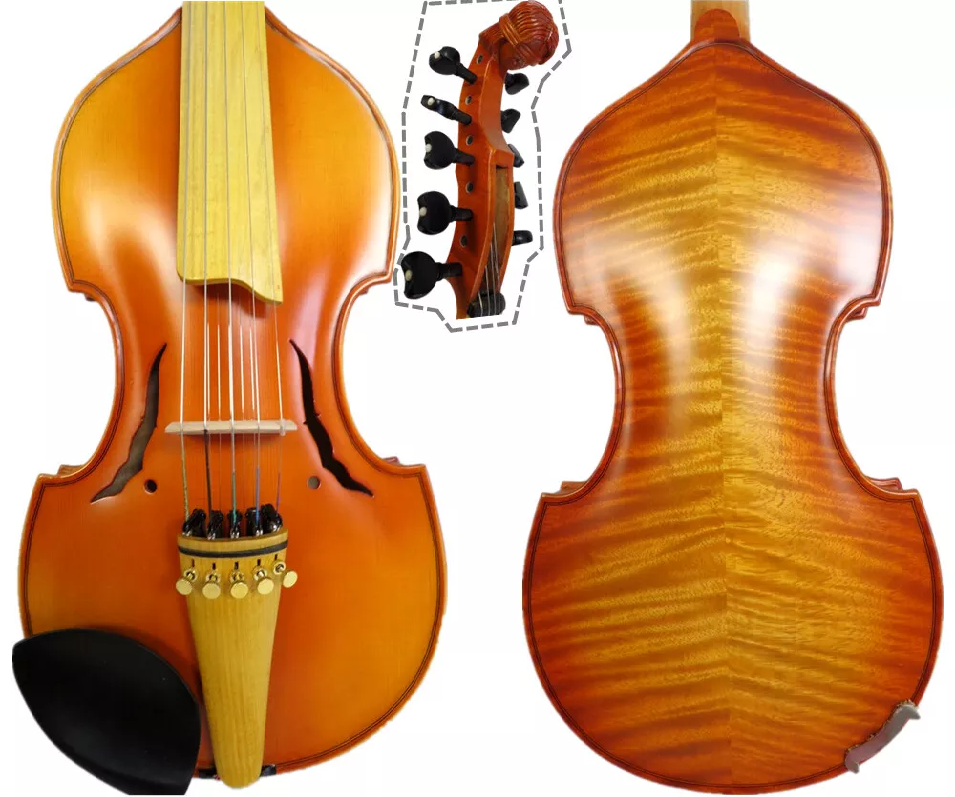Viola d’amore
Bowed Instruments
Europe
Between 1001 and 1900 AD
Video
The Viola d’Amore is a stringed musical instrument that belongs to the viol family and is known for its distinctive, sweet, and resonant sound. With sympathetic strings that vibrate along with the played notes, the Viola d’Amore creates a rich, ethereal tone that has captivated musicians and listeners for centuries.
History of the Viola d’Amore
Origins and Early Development
The Viola d’Amore first appeared in the late 17th century in Europe, during the Baroque period. The name “Viola d’Amore” translates to “viola of love,” likely referring to its warm and expressive tonal qualities. The instrument evolved from earlier bowed string instruments such as the viola da gamba and was influenced by the Arabian rebab.
The earliest known references to the Viola d’Amore date back to the writings of Marin Mersenne and Michael Praetorius. These sources suggest that the instrument was highly valued for its expressive capabilities and unique sound.
Popularity in the Baroque Period
The instrument gained significant popularity during the Baroque period, particularly in Germany, Italy, and France. Composers such as Heinrich Ignaz Franz Biber, Antonio Vivaldi, and Johann Sebastian Bach wrote pieces featuring the Viola d’Amore. Many virtuoso violinists and violists of the time were drawn to the instrument because of its ability to produce harmonically rich overtones.
Decline in the Classical and Romantic Eras
As orchestral music evolved, the Viola d’Amore saw a decline in use. The Classical and Romantic periods favored instruments with greater dynamic range and projection, leading to the dominance of the modern violin, viola, and cello in orchestral and chamber music settings. Although some composers, including Mozart and Meyerbeer, used the instrument in specific works, its presence in mainstream music diminished.
Revival in the 20th and 21st Centuries
Interest in the Viola d’Amore was revived in the 20th century, driven by historical performance movements and renewed appreciation for Baroque music. Musicians and composers began rediscovering its unique sound, leading to new compositions and performances. Today, it is used in both historical and contemporary contexts, including film scores and experimental music.
Characteristics
The Viola d’amore stands out due to its sympathetic strings, which create an ethereal, resonant tone that is richer than a standard violin or viola. It has a rounded body shape, typically with flame-shaped soundholes, rather than the f-holes found on violins. Many instruments feature an elaborately carved pegbox, sometimes with a human or animal head. The instrument is slightly larger than a viola but is played similarly, resting on the shoulder.
Construction and Design
The Viola d’Amore resembles a violin or viola but with distinct differences. It typically has six or seven bowed strings and an equal number of sympathetic strings that run underneath the fingerboard. These sympathetic strings vibrate in response to the played notes, enhancing the instrument’s harmonic richness.
The body of the Viola d’Amore is traditionally made of spruce (for the top plate) and maple (for the back and sides). The craftsmanship often features intricate carvings, elaborate scrollwork, and decorative inlays. Many Viola d’Amores also have a carved head instead of the traditional scroll, often depicting a cherub or other ornate figures. The bowed strings are typically made of gut (or synthetic materials in modern versions), while the sympathetic strings are usually made of metal. The tuning of the instrument varies but is often based on the key of the piece being performed. One of the common tunings is:
Bowed Strings: A–D–A–D–F#–A–D (from lowest to highest)
Sympathetic Strings: Tuned in a manner that enhances the harmonic resonance
The bridge of the Viola d’Amore is designed to accommodate both sets of strings, allowing the sympathetic strings to vibrate freely. The sound post inside the instrument helps project the sound while maintaining tonal balance.
Playing Techniques
Bowing
The playing technique of the Viola d’Amore is similar to that of the violin or viola. However, because of the multiple strings, the bowing technique requires careful control to avoid unintended string crossings. Baroque-style bows are often used for historical accuracy.
Fingering and Left-Hand Technique
Due to the sympathetic strings, fingering must be precise to ensure clean intonation. The lack of frets, unlike the viola da gamba, means that vibrato and ornamentation play crucial roles in shaping the tone.
Double Stops and Chords
The Viola d’Amore’s tuning allows for easy execution of double stops and chords, making it well-suited for polyphonic and harmonically rich music.
Repertoire and Notable Composers
Many composers from the Baroque period wrote music for the Viola d’Amore. Some notable works include:
Antonio Vivaldi – Concerto in D major, RV 392
Heinrich Ignaz Franz Biber – Sonatas for Viola d’Amore
Johann Sebastian Bach – Use of Viola d’Amore in his St. John Passion
Though less common in these periods, composers like Christoph Willibald Gluck and Wolfgang Amadeus Mozart included the Viola d’Amore in certain operatic and chamber works. Composers such as Paul Hindemith, Benjamin Britten, and Arvo Pärt have written for the instrument, further expanding its role in contemporary music.
Role in Different Music Traditions
In Baroque ensembles, the Viola d’Amore is often used in historically informed performances. Many musicians specializing in early music have embraced the instrument. The unique tone of the Viola d’Amore has been featured in modern film scores and experimental compositions, adding an evocative and mysterious quality to soundtracks.
It is a fascinating and historically rich instrument with a unique sound that continues to inspire musicians and audiences. Though it experienced periods of obscurity, its revival in modern times has ensured that its expressive and resonant voice remains part of the global musical landscape. Whether in Baroque concertos, contemporary compositions, or film scores, the Viola d’Amore remains a beloved instrument with a timeless appeal.
FAQ
What are the advantages of the Viola d'amore?
The Viola d'amore has sympathetic strings that enhance resonance, creating a rich, warm tone. Its unique tuning allows for expressive playing, and it blends well with baroque ensembles. The instrument's historical significance makes it a fascinating choice for period music enthusiasts.
How does the Viola d'amore perform compared to other string instruments?
The Viola d'amore requires specialized technique due to its tuning and extra strings. It offers a smooth and ethereal sound, making it ideal for baroque and early classical pieces. Though not as versatile as a violin, it excels in expressiveness and tonal depth.
What kind of sound does the Viola d'amore produce?
The Viola d'amore produces a warm, silvery, and hauntingly resonant sound. Its sympathetic strings vibrate freely, adding a natural reverb effect. This results in a delicate yet full-bodied tone, often compared to the human voice in its expressiveness.
 Links
Links
References
Other Instrument
Categories



















